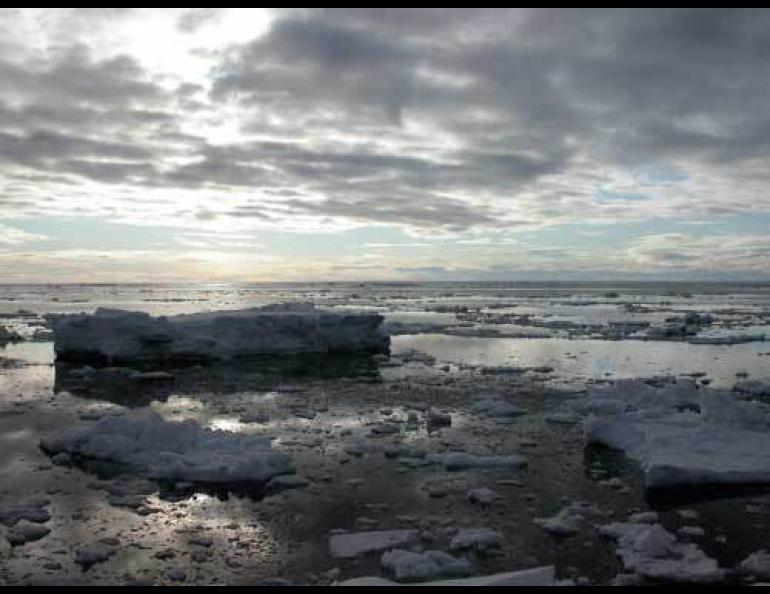
Northern sea ice takes a big hit in 2007
SAN FRANCISCO—For the past few years, vanishing northern sea ice has been a theme of many talks and posters here at the fall meeting of the American Geophysical Union, which draws about 15,000 scientists to the Moscone Center during the weeklong conference. At a press conference here on Wednesday, Dec. 12, 2007, scientists revealed that the ice on top of the northernmost ocean took a punch in the summer of 2007 that might be a knockout blow.
In 1980, the dense ice that floats on the Arctic Ocean like a large, moving jigsaw puzzle took up about the same area as the entire Lower 48 states; in September 2007, it was about as big as the U.S. east of the Mississippi River, said Don Perovich of the U.S. Army Cold Regions Research and Engineering Laboratory in New Hampshire. The ice loss in 2007, 23 percent greater than the previous record in 2005, has some scientists here predicting that the northern sea ice will vanish in summer as soon as five years from now. Perovich agreed that one of the greatest environmental changes people have ever seen might be close at hand.
“I used to say that sometime in my children’s lifetimes (sea ice covering the Arctic Ocean would disappear for half the year), but now I might see it,” said Perovich, who is in his 50s.
John Walsh of the International Arctic Research Center in Fairbanks was, along with Perovich, one of four scientists facing reporters from all over the world on Wednesday morning. Walsh spoke of how warmer water from the Atlantic has been entering the Arctic Ocean.
“We’re really moving into record territory in the last four or five years,” Walsh said, citing the work of IARC’s Igor Polyakov, who coordinates an annual scientific cruise in the Arctic Ocean.
While surprisingly warm water from the Atlantic is entering the Arctic Ocean—which probably adds to the loss of sea ice by melting it from beneath—unusually warm water from the Pacific is also invading the Arctic Ocean through the Bering Strait, said Mike Steele of the University of Washington.
“In 2007, north of Alaska and eastern Siberia, the Arctic Ocean was 3.5 degrees Celsius warmer than the historical average and 1.5 degrees warmer than the historical maximum,” Steele said, adding that waters off Alaska were especially warm. “The Bering Strait and Chukchi Sea are warming most.”
Because ice reflects about 85 percent of the sun’s radiation and open water only reflects 7 percent, 2007’s low ice led to the ocean absorbing much more of the sun’s heat. Perovich calculated that the Arctic Ocean in September 2007 absorbed 300 percent more solar energy than it did in 1980. He said that the sun was the real culprit in the loss of sea ice this year, and that the warm pulses of Atlantic and Pacific water also eroded the ice pack.
Perovich and his colleagues monitored a piece of sea ice off Alaska’s coast on the Beaufort Sea this year, finding it was almost 11 feet thick in June but shrunk to less than two feet thick by September. Ice seems to be at least three feet thinner than normal almost everywhere scientists have measured it.
“That missing meter of ice means the ice is more vulnerable,” Steele said.
The loss of ice in the summer will happen soon unless things change drastically, the scientists said.
“As you go further down this path, it’s harder to get back,” Perovich said. “It’s the fourth quarter now, and we’re down two touchdowns.”
For all the dire predictions that would spell the doom of the polar bear and other creatures that depend on sea ice, the sea ice could still bounce back, Steele said.
“Ice grows quickly when the air is really cold,” he said. “A recipe to bring the ice back is a few cold winters in a row.”




